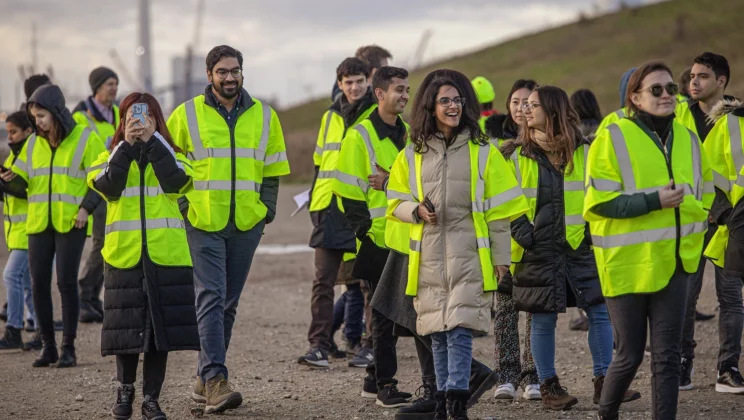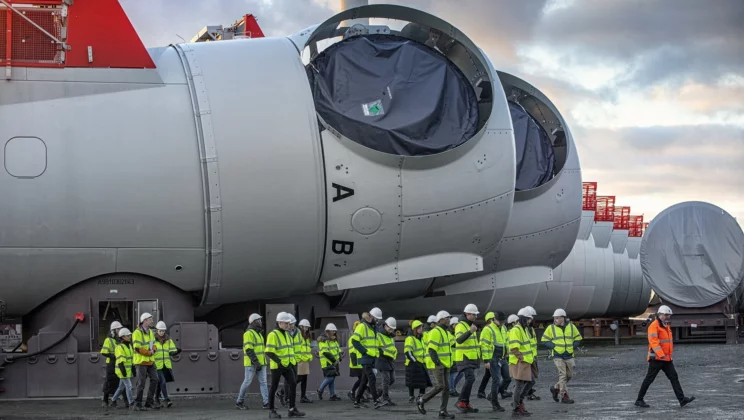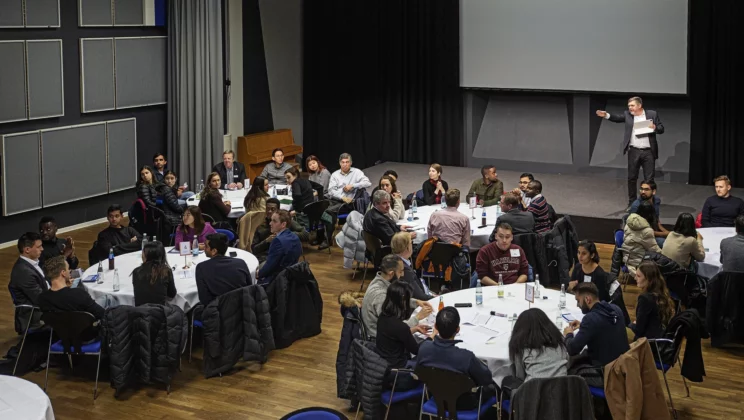Harvard Business School is regarded as one of the world’s leading universities, and Professor Willy Shih, who lectures on the MBA programme, identified Port Esbjerg as one of the best cases on the green transition and took the initiative to arrange a visit. That is why 44 dedicated MBA students from Harvard visited the port in early January. Both parties hope for a more permanent collaboration. “We’ll go home wiser and hopefully inspire others with some of the things we learnt from our visit,” says the Harvard professor who came up with the idea for the trip.
“A very warm welcome to you all,” says Jesper Bank, CCO of Port Esbjerg. From his vantage point of a small indoor crane, Jesper Bank is welcoming the 46 guests from Harvard Business School, who are standing in a warehouse on the harbour of Esbjerg.
The 44 students and two professors have travelled to Esbjerg to share in the port’s expertise. The world-renowned business school reached out to Esbjerg because, for the first time ever, it had been decided to arrange a study tour to explore the actual production of the green transition.
And Port Esbjerg became the destination of the first visit on this very first study tour.
“Usually Harvard collaborates with and visits companies like Toyota, Tesla and the like. So the fact that the students and their professors are coming to see us is huge,” says Dennis Jul Pedersen, CEO of Port Esbjerg.
Harvard Business School is considered one of the world’s leading universities and is a member of the exclusive Ivy League, comprising the top eight private universities in the United States.
It was Professor Willy Shih who decided that a trip to Denmark and Esbjerg would be particularly appropriate to inspire his students.
“Here in Denmark, you’re many years ahead of the United States in terms of wind energy, not least offshore wind. We’re visiting to give our students the opportunity to be inspired by what you’ve created here in Denmark. And not least in Esbjerg, as the world’s largest wind port. Here, our students will have the exciting opportunity to visit some of the world’s leading companies in the field,” says Professor Shih.

The 44 students and two professors from Harvard Business School have travelled to Esbjerg to explore the actual production of the green transition.
A unique programme for a unique visit
Back in the warehouse, Jesper Bank shares good news with the students.
“We’ve managed to put together a unique programme for you, so you’ve got lots to look forward to,” he says, while still standing on the small indoor crane and wearing the traditional orange harbour jacket over his suit.
The students react with applause and whoops.
“We’re changing society as we know it. The green transition demands dramatic changes, and as you’ll see today, many of those changes involve ports like Port Esbjerg,” says Jesper Bank.
After being handed bags with safety equipment, the visitors board two buses that take them to their first visit.
At European Energy, the students stand below the four 200-metre test turbines that European Energy has erected by the sea, whose output correspond to the consumption of some 27,000 households.
“Here, behind the hill, we’ll build our hydrogen plant, so we can convert the electricity into other usable forms of energy,” says Mikael D. Pedersen of European Energy.
He takes his audience by storm.
“You see wind turbines on TV and in films, and they’re impressive. But to actually be able to touch one, to stand next to a turbine and hear the blades whizzing overhead, now that’s really amazing! It was such an inspiring experience for me, and it makes me very hopeful to see the amazing scale of what’s happening here in Esbjerg,” says Sam Deutch from Washington, who is studying for an MBA at Harvard Business School.

Port Esbjerg had put together a unique programme for the Harvard guests. Amongst others, they visited Siemens Gamesa, Vattenfall, and European Energy.
Excellent advice from Vattenfall’s control centre
Next up is the Vattenfall Control Centre, which monitors all of Vattenfall’s 1,200 turbines at 52 sites across Europe.
Here, the Harvard students visit the control room, where the employees keep a close eye on the weather and thirty screens provide all kinds of information relevant to Vattenfall’s wind farms across Europe. This set-up ensures that the turbines are managed in the best possible way and that technicians are brought ashore if the weather turns bad.
“We can predict most things. For example, we’re pulling our people in from the sea at the moment, and you probably shouldn’t be too late getting back to your hotel tonight either, because the forecast is for rain and strong winds,” says Vattenfall’s weather expert.
In the next room, there are even more screens. They show Vattenfall’s wind turbines in all the various locations around Europe. The cameras provide an overview, and all turbines can be restarted from the control centre and technicians can be called, if a turbine has a fault.
“Do you shut off the turbines when a storm is brewing – like tomorrow?” one of the students pipes up.
“Yes, if the wind is strong enough, it may be better to turn the blades so they face away from the wind,” is the affirmative answer.
The students take notes and ask for further details.
The students have paid for both their accommodation and flights, so the students visiting the harbour are serious and committed to their studies.
In fact, one of the students, who will be working with green investments, demanded that his future employer let him go on the study tour. Otherwise, he would not accept the position.
His future employer agreed.
Se mere fra dagen og hør, hvad dagens deltagere har at sige om besøget.
Climbing around in a hot nacelle
At Siemens Gamesa, which has a large storage area at the port, the students get the opportunity to climb into a nacelle and experience the conditions of the space that the turbine technicians have to move around in while the turbines are at sea. There is very little space, no windows, and at sea, the nacelle may swing up to twenty metres back and forth when the wind really picks up. At the same time, it is hot and very noisy inside the nacelle.
“It’s absolutely amazing to be able to get inside an offshore wind turbine and see what it actually looks like. It’s such a tangible manifestation of the green transition, and it’s just really incredible,” says Sam Deutch.
To round off the company visits, the students are going on a sea trip. Well, almost. The 46 guests dressed in yellow vests will visit the 133-metre Sea Challenger, one of only twenty wind installation vessels in the world, which has made a short stop at Esbjerg.
Standing under a crane hook the size of a car (which can lift 900 tonnes), captain Brian Bendixen explains how the vessel gets the giant wind turbine components on board and how they are planted in the seabed. Then the visitors go on the bridge to see where the vessel is steered.

They students got to see a nacelle from the inside. "It’s such a tangible manifestation of the green transition, and it’s just really incredible,” says Sam Deutch, MBA student at Harvard Business School.
Esbjerg wants something in return
The tour gives the students a unique insight into the work on the green transition at the port. However, extending the invitation to the students is not an act of pure hospitality.
“We want something in return. Hopefully, this visit will form the basis for even more dialogue. We make ourselves available and contribute our latest experience. In return, Harvard has the opportunity to provide us with an analytical and commercial approach,” explains Dennis Jul Pedersen and he continues:
“The aim is to join forces in order to professionalise the wind industry and create innovation, development and business in the course of the green transition.”
The intention is that the study tour to Esbjerg will be followed up by online seminars and future meetings.
“The fact that we’ve now established a collaboration with one of the world’s leading universities says a lot about how ambitious we are on behalf of the Port Esbjerg. We already have world-leading expertise and have every intention of staying at the forefront of our field,” says Dennis Jul Pedersen.
Jutland is a unique green cluster
Professor Shih, who chose Esbjerg as the destination of the study tour, says that the whole of Jutland is a green powerhouse, which is easy to spot even from a prestigious institution like Harvard.
“Esbjerg and the rest of Jutland is a unique green cluster, and the students had an amazing experience today,” he says.
The students’ tour of the harbour of Esbjerg is concluded with a working dinner and a roundtable discussion with CEOs and managers from some of the world’s leading offshore wind companies. It is the perfect opportunity to exchange ideas, issues and solutions concerning offshore wind, energy production and the green transition.
“Both Harvard and Port Esbjerg represent strong networks and relationships with market leaders from international organisations and companies. So we can hone each other’s skills. Harvard can provide an analytical approach and produce some of the data that we don’t have in industry, and maybe take a global perspective. That’s why we hope our collaboration will continue,” says Dennis Jul Pedersen.
Henrik Otto Jensen, CEO of the Niels Winther Group, which is one of Esbjerg’s leading suppliers of integrated shipping solutions, is one of the guests at the dinner. He is very keen to cement the dialogue:
“It’s very important to have these kinds of discussions, where we exchange ideas, experience and ways of thinking. That’s how both parties learn to think differently. In the green transition, we depend on science, and the students gave us some good input today, and I think we also gave them food for thought,” says Henrik Otto Jensen.
Professor Shih is also hopeful.
“I hope that our collaboration with Port Esbjerg will continue. We’ll go home wiser and hopefully inspire others with some of the things we learnt from our visit,” he says.
When Jesper Bank closes the evening on behalf of Port Esbjerg, the students applaud and whoop like they did when their tour began nine hours earlier.
Sam Deutch from Washington sums up his day like this:
“We’ve seen tremendous dedication and gained knowledge about offshore wind that we don’t have on that scale in the United States. When I go back home to study and work, I’ll take a lot with me that I can use in the United States to get us further in the green transition.”

The students’ tour of the harbour of Esbjerg concluded with a working dinner and a roundtable discussion with CEOs and managers from some of the world’s leading offshore wind companies
Go to overview

